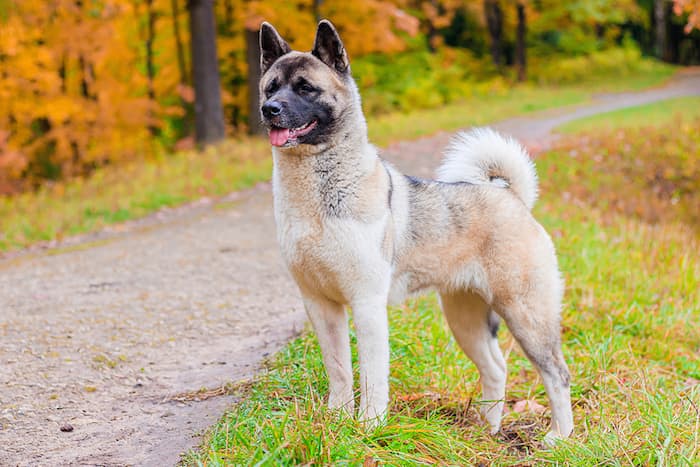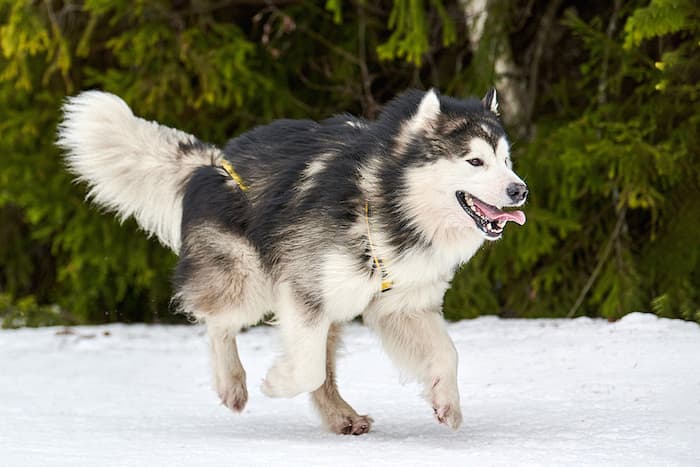All dogs descended from wolves. In fact, wolf and dog DNA differ by a mere 0.2 percent. Genetically speaking, domestic dogs are much closer to wolves than even coyotes are. Wolf and coyote DNA differs by four percent. A study called CanMap was conducted by UCLA, Cornell University, and the National Institutes of Health. It endeavored to discover what the closest dog to a wolf is. They gathered DNA from 1000 canines representing 85 breeds. This study concluded that the Akita, Alaskan Malamute, Shiba Inu, and Chow Chow were the closest dog breeds to wolves.
Professor Merete Fredholm at the University of Copenhagen states that previously accepted scientific belief has been that all dogs are descended from one wolf pack in China. However, more recent evidence shows that many human cultures and civilizations domesticated dogs at different times. The consensus at England’s Durham University is that all modern dogs are directly and exclusively descended from gray wolves. However, there has been so much canine cross-breeding over the past few hundred years or so that it’s now nearly impossible to trace a direct link from a modern dog to the wolf. Researchers can only make generalizations based on the genetic evidence they have, which is what the CanMap study did.
Moreover, dogs in recent times have been bred for not only specific tasks but for companionship. Dogs are now pets, which further alters their behavior and blurs the wolf-dog line even more. However, here are some facts about the four breeds from the CanMap study:
What Dogs are Closest to Wolves?
- Akita
- Shiba Inu
- Chow Chow
- Alaskan Malamute
Akita
This magnificent Japanese breed is sometimes called a wolf hybrid. They resemble a wolf with a curly flip tail.
Shiba Inu
This curly-tailed Japanese hunting dog looks somewhat like a very small red wolf. They are smart, charming, faithful, and fearless.
Chow Chow
These are sturdy, blue-tongued, independent, and loyal dogs with a double coat and curly tail. Often red, they can also be black, blue, cream or fawn.
Alaskan Malamute
These are large dogs that look a great deal like a wolf. Devoted, strong, loyal, and with thick coats, they were often used to pull sleds in Arctic environments.
Studies That Connect Dogs to Wolves
There have been numerous studies comparing dogs and wolves to better understand the relationship between the two species. Some of the key findings from these studies include:
- Genetic studies: Research comparing the DNA of dogs and wolves has shown that dogs are descended from wolves, and that the two species share a common ancestor. However, there is some debate over when and where dogs were domesticated, with some studies suggesting that it occurred in multiple locations over time.
- Behavioral studies: Studies of wolf behavior have helped researchers better understand the social dynamics and communication methods used by dogs. For example, studies have shown that dogs and wolves both use body language to communicate, although dogs have evolved to be more expressive and use a wider range of signals than wolves.
- Cognitive studies: Researchers have conducted numerous studies comparing the cognitive abilities of dogs and wolves, including tests of problem-solving, memory, and social cognition. These studies have shown that while dogs and wolves share many cognitive abilities, dogs are better at reading and responding to human cues, likely due to their long history of domestication.
Genetic Studies
Some of the most well-known genetic studies include those conducted by:
- Peter Savolainen and colleagues at the Royal Institute of Technology in Sweden, who conducted a study in 2002 that suggested dogs were domesticated in East Asia around 15,000 years ago.
- Robert Wayne and his team at the University of California, Los Angeles, who conducted a study in 2013 that suggested dogs were domesticated from a group of wolves in Europe around 19,000 to 32,000 years ago.
- Adam Boyko and his colleagues at Cornell University, who conducted a study in 2010 that used DNA analysis to identify the genetic signatures of various dog breeds and trace their ancestry back to specific wolf populations.
Behavioral Studies
Some notable researchers in this field include:
- Raymond Coppinger, a biologist at Hampshire College, who studied the behavior of free-ranging village dogs in Mexico and compared their behavior to that of wolves.
- Brian Hare, an evolutionary anthropologist at Duke University, who has conducted numerous studies comparing the cognitive and social behavior of dogs and wolves.
- Friederike Range and Zsófia Virányi, researchers at the Messerli Research Institute in Austria, who have conducted studies comparing the social cognition and problem-solving abilities of dogs and wolves.
Cognitive Studies
Some notable researchers in this field include:
- Ádám Miklósi and his colleagues at Eötvös Loránd University in Hungary, who have conducted studies on the social cognition of dogs and how they communicate with humans.
- Juliane Kaminski and her colleagues at the University of Portsmouth in the UK, who have conducted studies on how dogs use visual cues to solve problems and communicate with humans.
Sources
- Savolainen et al. (2002) – “Genetic Evidence for an East Asian Origin of Domestic Dogs”, Science: https://science.sciencemag.org/content/298/5598/1610
- Wayne et al. (2013) – “Ancient DNA Reveals European Origin of Dogs”, Science: https://science.sciencemag.org/content/342/6160/871
- Boyko et al. (2010) – “Complex population structure in African village dogs and its implications for inferring dog domestication history”, PNAS: https://www.pnas.org/content/107/33/15107
- Coppinger and Schneider (1995) – “Evolution of Working Dogs”, Encyclopedia of Animal Behavior: https://www.sciencedirect.com/science/article/pii/B9780080453378001751
- Hare et al. (2002) – “The domestication of social cognition in dogs”, Science: https://science.sciencemag.org/content/298/5598/1634
- Miklósi et al. (1998) – “A simple reason for a big difference: wolves do not look back at humans, but dogs do”, Current Biology: https://www.cell.com/current-biology/fulltext/S0960-9822(98)70458-0
- Kaminski et al. (2008) – “Domestic dogs’ (Canis familiaris) understanding of human pointing and gaze direction in object-choice tasks”, Journal of Comparative Psychology: https://psycnet.apa.org/record/2008-13039-004
- Range and Virányi (2015) – “Social learning from humans or conspecifics: differences and similarities between wolves and dogs”, Frontiers in Psychology: https://www.frontiersin.org/articles/10.3389/fpsyg.2015.00088/full
- Udell et al. (2010) – “Can your dog read your mind? Understanding the causes of canine perspective taking”, Learning & Behavior: https://link.springer.com/article/10.3758/LB.38.3.289
Other Physical Characteristics





